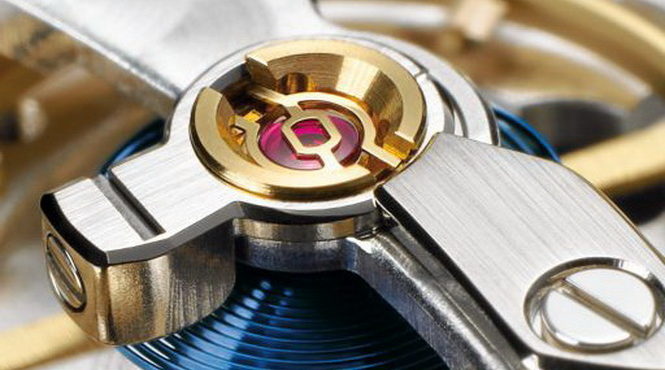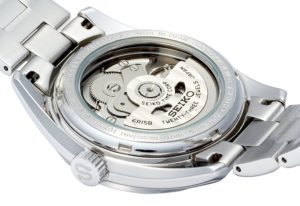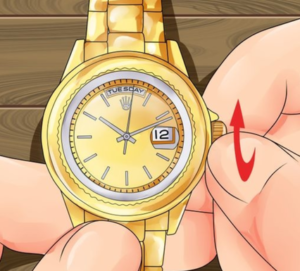
I have many customers who are getting a mechanical watch for the first time. They ask me questions about the care and feeding of their new watch. Because of this, here are some frequently asked questions and some answers.
Can You Wind an Automatic Watch?
Yes, you can wind an automatic watch from the crown. That will not hurt the movement.
You will never come to the “end” of the mainspring on an automatic watch. The spring will slip as it gets close to fully wound.
Actually, with an older or worn watch, a few manual winds from the crown can be a big help.
Check this blog post for more info on how an automatic watch works:
What Does Fully Automatic Mean?
Fully automatic means that the watch can’t be wound from the crown. The only watch that comes to mind is a basic Seiko auto.
They have eliminated the winding pinion on the watch so that the only way to wind the watch is to wear it and have the auto do its work.
I have no idea why they did this, just a different idea of how to design an automatic watch.

Can You “Overwind” a Watch?
No, you can’t overwind a watch. The reason that people say they have overwound a watch is that they wind it up and the watch does not run. So, they think that they have broken something by winding it too much.
A normal person is not strong enough to break a manual wind watch by just winding it.
How to Wind a Mechanical Watch
Wind the watch by turning the crown clockwise a number of complete revolutions.
With the watch face-up in your left hand, pinch the crown between your right forefinger and thumb and rotate the crown clockwise. “Clockwise” means rotating it away from you.
Wind slowly and consistently. Wind the crown as far as you can in each turn and then release it and start again.
Always wind your watch while it is off your wrist, this puts less stress on the stem/crown.

My Watch Did Not Start Up When it Was Fully Wound, is This a Problem?
No, this is not a problem. For a watch to start up from a dead stop when wound, everything must be in “perfect” condition.
The watch must be perfectly clean, it must be in beat and hairspring and escapement also must be adjusted properly.
A slight “twist” to get the balance wheel started is not a problem.
Why Don’t You Want to Fix My Watch After First Saying that You Will?
Normally when a watch comes into my shop for repair, I take a quick look and give you an “estimate” for its repair.
Once the customer gives the go ahead, then I begin the repair and take the watch out of the case and prepare for the overhaul.
At this point, I get the dial and hands off and have the opportunity to carefully look over each part to see how the watch looks.
I often find problems that were not apparent after the first quick look and at this time I may make a decision that the watch is not a good candidate for a simple overhaul.
I try and explain to the customer that the watch is old, worn, rusty, needs lots of parts etc. and I think that they should not invest a lot of money into this particular watch.
I want to try and save the customer money and save me from wasting my time.
This post may answer more questions about how my business is run.
How Many Winds for a Pocket Watch?
You should be able to wind a pocket watch about 20-25 turns to get it fully wound.
Is the Power Reserve that I Read About on the Internet Correct?
The 38-40 plus hour power reserve that you read about in chat rooms or in other places on the internet is often misleading.
The power reserve on an automatic watch is going to depend on the quality of the watch, is it clean and oiled properly, is the mainspring properly lubricated, is the customer wearing the watch 12-14 hours a day and staying “active,” etc.
No two people have the same activity level each day, some walk to work, some drive. Some people work at a desk all day, some do manual labor etc.
You can’t compare apples to oranges when talking about power reserve on a watch.
For me, if you wear the watch all day, take it off in the evening, it should be on time the next morning approximately 12 hours later.
Expecting a watch to run for a day-and-a-half on just a few hours of wear is asking a lot of any mechanical watch.
I did a blog on this subject:
Why Won’t You Change my Rolex Plastic Crystal to Sapphire?
Your Rolex case was designed for a plastic crystal and that is the way it should stay.
If you try and go with an often market sapphire crystal on a watch designed for plastic, there is a good chance the watch will not stay watertight.
Why Won’t You Just Change the Crystal on a Rolex Without a Complete Overhaul?
Customers often call and tell me that they just dropped their Rolex and broke the crystal. They tell me the watch “was” running great before the drop and they don’t think it needs anything else done.
This all sounds good, but the problem is if you drop a watch hard enough to break a sapphire crystal, then there is the real possibility of damaging the movement.
The other issue is that when sapphire breaks, it normally will leave small pieces of glass under the crystal that can easily make their way into the movement through the date window or through the center.
If you just change the crystal and don’t remove the dial, there is no way to make sure these small pieces wont make their way into the movement and cause trouble in the future.
Keep in mind that it does not take much dirt or debris to stop a watch, so glass inside the movement is a real problem.
If anyone has a question that they want answered, just let me know in the comments section or by sending me an email.
CHARLEY PHOTO OF THE WEEK: Charley had some dry skin and a crack on her paw pad. Wearing a booty was a minor setback for her, but she chose to make big deal about it.

